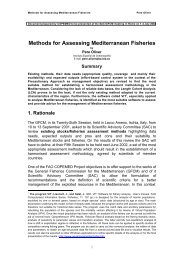Cours sur les méthodes d'évaluation acoustique ... - Fao - Copemed
Cours sur les méthodes d'évaluation acoustique ... - Fao - Copemed
Cours sur les méthodes d'évaluation acoustique ... - Fao - Copemed
You also want an ePaper? Increase the reach of your titles
YUMPU automatically turns print PDFs into web optimized ePapers that Google loves.
Cartesian coordinate system 8Representing a vector in the standard basisA point in space in a Cartesian coordinate system may also be represented by a vector, which can be thought of as anarrow pointing from the origin of the coordinate system to the point. If the coordinates represent spatial positions(displacements) it is common to represent the vector from the origin to the point of interest as . In threedimensions, the vector from the origin to the point with Cartesian coordinates is sometimes written as: [5]where , , and are unit vectors and the respective versors of , , and axes. This is the quaternionrepresentation of the vector, and was introduced by Sir William Rowan Hamilton. The unit vectors , , andcalled the versors of the coordinate system, and are the vectors of the standard basis in three-dimensions.ApplicationsEach axis may have different units of mea<strong>sur</strong>ement associated with it (such as kilograms, seconds, pounds, etc.).Although four- and higher-dimensional spaces are difficult to visualize, the algebra of Cartesian coordinates can beextended relatively easily to four or more variab<strong>les</strong>, so that certain calculations involving many variab<strong>les</strong> can bedone. (This sort of algebraic extension is what is used to define the geometry of higher-dimensional spaces.)Conversely, it is often helpful to use the geometry of Cartesian coordinates in two or three dimensions to visualizealgebraic relationships between two or three of many non-spatial variab<strong>les</strong>.The graph of a function or relation is the set of all points satisfying that function or relation. For a function of onevariable, f, the set of all points (x,y) where y = f(x) is the graph of the function f. For a function of two variab<strong>les</strong>, g,the set of all points (x,y,z) where z = g(x,y) is the graph of the function g. A sketch of the graph of such a function orrelation would consist of all the salient parts of the function or relation which would include its relative extrema, itsconcavity and points of inflection, any points of discontinuity and its end behavior. All of these terms are more fullydefined in calculus. Such graphs are useful in calculus to understand the nature and behavior of a function orrelation.Notes[1] "analytic geometry". Encyclopædia Britannica (Encyclopædia Britannica Online ed.). 2008.[2] Descartes, R. La Géométrie (http://gallica2.bnf.fr/ark:/12148/bpt6k29040s.image.f1.langEN). Livre Premier: Des problèmes qu'on peutconstruire sans y employer que des cerc<strong>les</strong> et des lignes droites (Book one: Problems whose construction requires only circ<strong>les</strong> and straightlines). . (French)[3] A Tour of the Calculus, David Brezinsky[4] Springer online reference Encyclopaedia of Mathematics (http://eom.springer.de/a/a010970.htm)[5] David J. Griffith (1999). Introduction to Electromagnetics. Prentice Hall. ISBN 0-13-805326-X.References• Descartes, René, Oscamp, Paul J. (trans) (2001). Discourse on Method, Optics, Geometry, and Meteorology.• Morse PM, Feshbach H (1953). Methods of Theoretical Physics, Part I. New York: McGraw-Hill. pp. 656.LCCN 52-11515. ISBN 0-07-043316-X.• Margenau H, Murphy GM (1956). The Mathematics of Physics and Chemistry. New York: D. van Nostrand.pp. 177. LCCN 55-10911.• Korn GA, Korn TM (1961). Mathematical Handbook for Scientists and Engineers. New York: McGraw-Hill.pp. 55–79. LCCN 59-14456, ASIN B0000CKZX7.• Sauer R, Szabó I (1967). Mathematische Hilfsmittel des Ingenieurs. New York: Springer Verlag. pp. 94.LCCN 67-25285.• Moon P, Spencer DE (1988). "Rectangular Coordinates (x, y, z)". Field Theory Handbook, Including CoordinateSystems, Differential Equations, and Their Solutions (corrected 2nd ed., 3rd print ed. ed.). New York:are
















